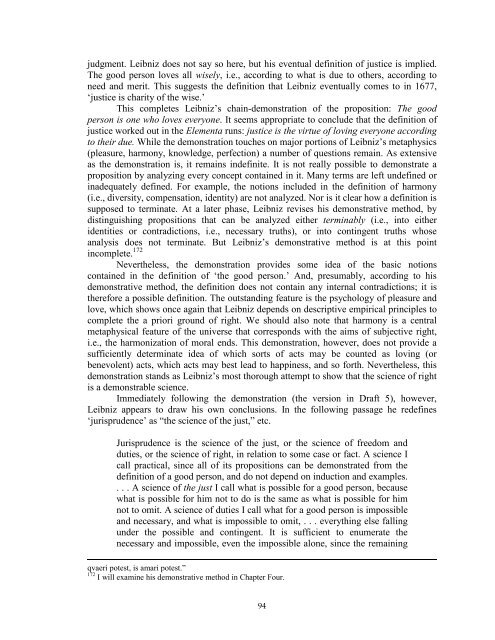Stony Brook University
Stony Brook University
Stony Brook University
You also want an ePaper? Increase the reach of your titles
YUMPU automatically turns print PDFs into web optimized ePapers that Google loves.
judgment. Leibniz does not say so here, but his eventual definition of justice is implied.<br />
The good person loves all wisely, i.e., according to what is due to others, according to<br />
need and merit. This suggests the definition that Leibniz eventually comes to in 1677,<br />
‘justice is charity of the wise.’<br />
This completes Leibniz’s chain-demonstration of the proposition: The good<br />
person is one who loves everyone. It seems appropriate to conclude that the definition of<br />
justice worked out in the Elementa runs: justice is the virtue of loving everyone according<br />
to their due. While the demonstration touches on major portions of Leibniz’s metaphysics<br />
(pleasure, harmony, knowledge, perfection) a number of questions remain. As extensive<br />
as the demonstration is, it remains indefinite. It is not really possible to demonstrate a<br />
proposition by analyzing every concept contained in it. Many terms are left undefined or<br />
inadequately defined. For example, the notions included in the definition of harmony<br />
(i.e., diversity, compensation, identity) are not analyzed. Nor is it clear how a definition is<br />
supposed to terminate. At a later phase, Leibniz revises his demonstrative method, by<br />
distinguishing propositions that can be analyzed either terminably (i.e., into either<br />
identities or contradictions, i.e., necessary truths), or into contingent truths whose<br />
analysis does not terminate. But Leibniz’s demonstrative method is at this point<br />
incomplete. 172<br />
Nevertheless, the demonstration provides some idea of the basic notions<br />
contained in the definition of ‘the good person.’ And, presumably, according to his<br />
demonstrative method, the definition does not contain any internal contradictions; it is<br />
therefore a possible definition. The outstanding feature is the psychology of pleasure and<br />
love, which shows once again that Leibniz depends on descriptive empirical principles to<br />
complete the a priori ground of right. We should also note that harmony is a central<br />
metaphysical feature of the universe that corresponds with the aims of subjective right,<br />
i.e., the harmonization of moral ends. This demonstration, however, does not provide a<br />
sufficiently determinate idea of which sorts of acts may be counted as loving (or<br />
benevolent) acts, which acts may best lead to happiness, and so forth. Nevertheless, this<br />
demonstration stands as Leibniz’s most thorough attempt to show that the science of right<br />
is a demonstrable science.<br />
Immediately following the demonstration (the version in Draft 5), however,<br />
Leibniz appears to draw his own conclusions. In the following passage he redefines<br />
‘jurisprudence’ as “the science of the just,” etc.<br />
Jurisprudence is the science of the just, or the science of freedom and<br />
duties, or the science of right, in relation to some case or fact. A science I<br />
call practical, since all of its propositions can be demonstrated from the<br />
definition of a good person, and do not depend on induction and examples.<br />
. . . A science of the just I call what is possible for a good person, because<br />
what is possible for him not to do is the same as what is possible for him<br />
not to omit. A science of duties I call what for a good person is impossible<br />
and necessary, and what is impossible to omit, . . . everything else falling<br />
under the possible and contingent. It is sufficient to enumerate the<br />
necessary and impossible, even the impossible alone, since the remaining<br />
qvaeri potest, is amari potest.”<br />
172 I will examine his demonstrative method in Chapter Four.<br />
94
















